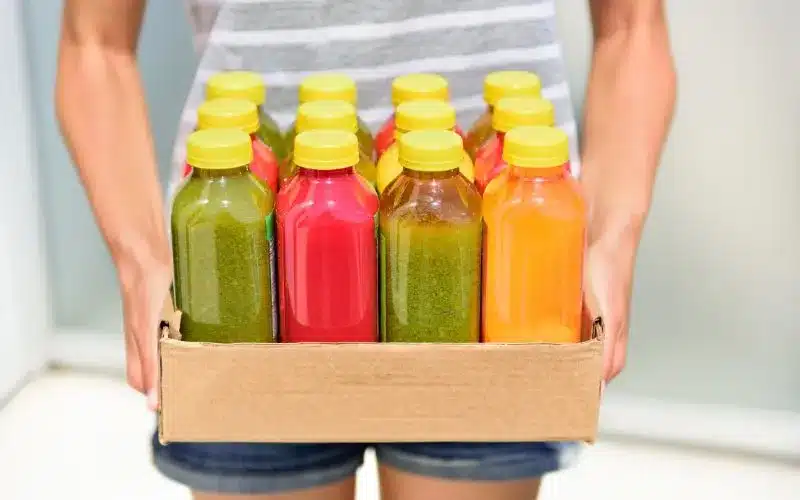
At its core, cold pressed juicing is a method of extracting juice from fruits and vegetables without applying heat. Unlike traditional juicing, which often involves fast-spinning blades that generate heat and destroy some of the juice’s nutritional properties, cold pressing uses a slow, deliberate process. It keeps the enzymes, vitamins, and minerals intact, preserving the juice’s nutritional integrity.
In short, cold pressed means the juice is made by pressing and squeezing—not shredding or spinning—which reduces oxidation and retains more nutrients.
A cold press juicer, also known as a masticating juicer, works in two steps:
This process avoids heat and air exposure, preserving freshness and shelf-life, while minimizing oxidation.
Cold pressing isn’t new. The technology has roots in ancient winemaking and olive oil production. But its popularity surged in the early 2010s, with brands like BluePrint and Pressed Juicery leading the charge.
Today, cold pressed juicing is a mainstay of the wellness movement, showing up everywhere from boutique juice bars to high-end grocery stores.
| Feature | Centrifugal Juicer | Cold Press Juicer |
|---|---|---|
| Speed | Fast | Slow |
| Heat Production | High | None |
| Noise Level | Loud | Quiet |
| Juice Shelf Life | 24 hrs | Up to 72 hrs |
| Nutrient Retention | Lower | Higher |
A centrifugal juicer works by using a rapidly spinning metal blade that grates the produce into pulp and separates juice using centrifugal force. Unfortunately, the process generates heat and exposes the juice to air, reducing its antioxidant and enzyme levels.
Cold pressed juices are smoother, richer, and more intense in flavour. They retain the natural taste of the ingredients. Traditional juices can taste flat due to the oxidation and heat affecting their aroma compounds.
Absolutely. Cold pressing protects:
Research from PubMed indicates cold pressed juices retain up to 42% more vitamin C compared to centrifugal juices.
Since there’s no heat involved, the nutritional profile remains almost entirely intact. Cold pressing maintains the raw state of the produce, locking in vitamins, enzymes, and minerals that otherwise degrade under heat.
“Cold pressing allows juice to serve as a true nutrient-dense elixir.” — Nutritionist Mia Rigden, CN (Well+Good)
Thanks to minimal exposure to oxygen and no heat, cold pressed juice can stay fresh in the fridge for up to 3 days. Traditional juice spoils within 24 hours. This makes it ideal for batch prepping.
Juicing removes most insoluble fiber, which allows your body to absorb nutrients faster. Cold pressed juice acts like a liquid multivitamin, making it great for people with digestive issues or recovering from illness.
Cold pressed juices—especially green blends with kale, spinach, and parsley—support your liver and kidneys. Their high content of chlorophyll, antioxidants, and hydration makes them natural detoxifiers.
Ingredients:
Benefits: Detoxifies the liver, alkalizes the body, boosts immunity
Ingredients:
Benefits: Packed with vitamin C, aids immunity, combats inflammation
Ingredients:
Benefits: Improves blood flow, reduces joint inflammation
Ingredients:
Benefits: Promotes glowing skin, rich in beta-carotene, supports eye health
Compare specs and reviews on JuicerKings for updated rankings.
Heat destroys enzymes. Oxygen causes oxidation which breaks down nutrients. Cold pressed juicing avoids both.
Cold pressing preserves:
These fragile nutrients degrade fast in traditional juicing methods.
| Juicer Type | Average Price | Lifespan |
| Centrifugal | $50–200 | 2-3 years |
| Cold Press | $150–500+ | 5-10 years |
Yes, the initial cost is higher. But what you gain in long-term health benefits, reduced medical bills, and fewer supplements more than makes up for it.
Cold pressed juicing encourages you to:
Pros:
Cons:
Technically yes. HPP uses high pressure instead of heat to kill pathogens, allowing juice to remain raw while staying shelf-stable. However, purists argue that it’s a compromise.
Cold pressed juicing isn’t a fad. It’s grounded in sound nutritional science and has been around for decades. Its recent popularity reflects growing awareness about clean eating.
Not necessarily. If you need more fiber in your diet, eating whole fruits or smoothies might be better. Juicing removes pulp and insoluble fiber.
Many store-bought versions are loaded with natural sugars and lack balance. Always read labels carefully. Look for options that include greens and veggies, not just fruits.
Cold pressed juice is now part of mainstream wellness culture. From urban juice bars to yoga studios, it’s a staple.
Nutritionists often recommend it as a way to increase micronutrient intake. Consumers report improved energy, skin clarity, and digestive health.
If you’re looking to boost your nutrition in a convenient, tasty way, cold pressed juicing is absolutely worth exploring. Whether you’re detoxing, recovering from illness, or simply trying to eat more plant-based, it fits in beautifully.

Hi my name’s Jessica Anderson, blogger, gardener, mom and wife. Discover my world and the love and passion I have for life. Find out what I have discovered and maybe it might just help enrich your life somehow.
Click to read on